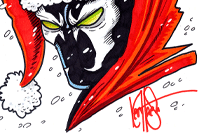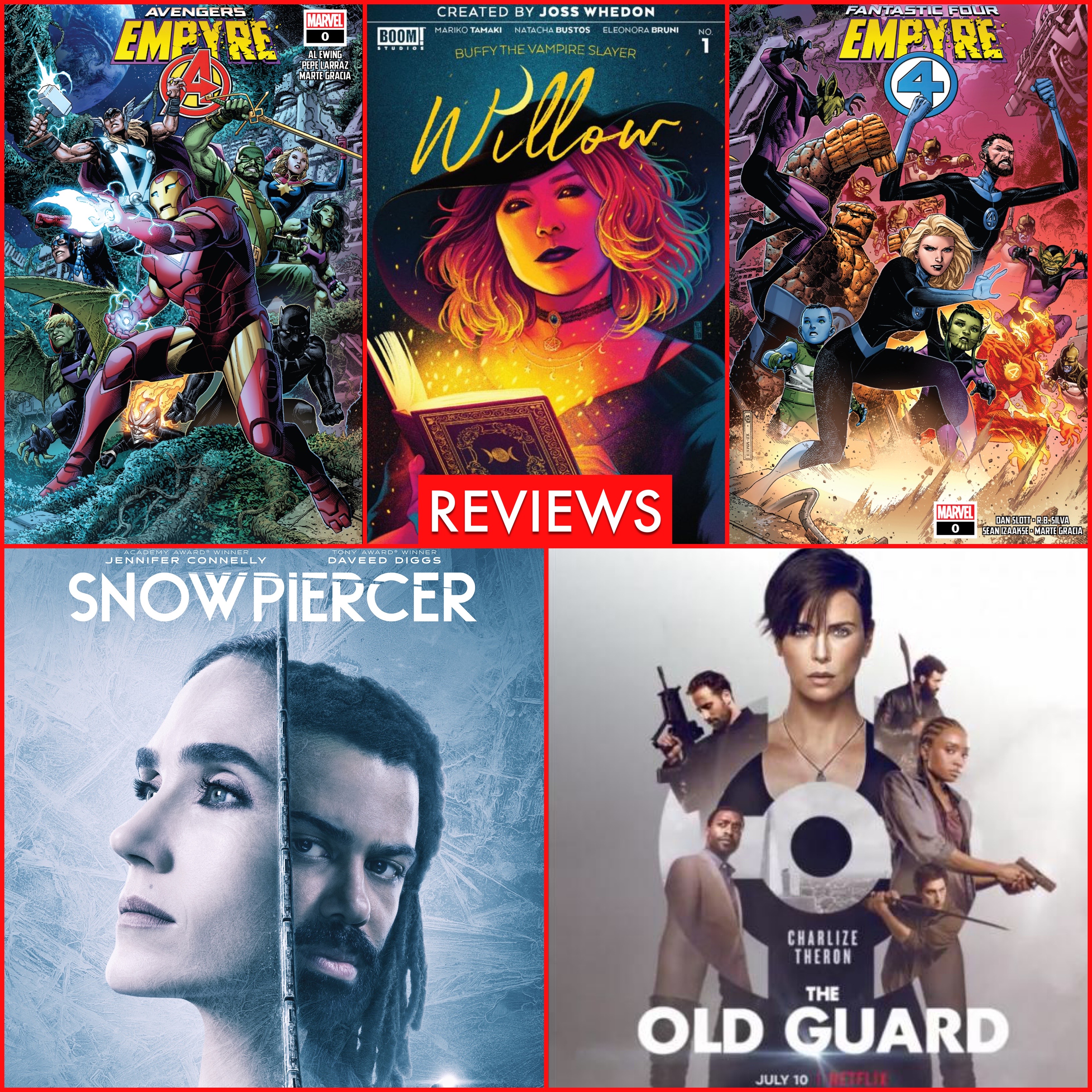|

|
ERIK MONA
 SEND THIS TO A FRIEND! SEND THIS TO A FRIEND!
DF Interview: Erik Mona talks Pathfinder, Paizo, the new Worldscape comic, more By Byron Brewer You have seen his name on many a Pathfinder comic book and maybe even ran into him at a convention, but who is Erik Mona? The scribe of many a Pathfinder adventure, his day – his life – are much more dedicated to the franchise than might at first meets the eye. DF puts the spotlight on one of the men behind one of the most popular brands in the world. Dynamic Forces: Erik, many may know you from your writing credit on various Pathfinder comics. But your duties with Pathfinder encompass much more than that. Tell us about Paizo and your world as its Publisher and Chief Creative Officer. Erik Mona: Paizo started in 2002 as a spin-off of Wizards of the Coast’s periodicals department, which at the time produced Dragon, Dungeon, and Polyhedron magazines for Dungeons & Dragons, as well as Star Wars Insider, the official magazine of the Star Wars Fan Club. I was in charge of Polyhedron at the time, which eventually became a part of Dungeon magazine. I was one of the original Paizo staff, and in the years since our founding I went on to become editor-in-chief of Dungeon and Dragon magazines. Soon after that, I became the company’s publisher, in charge of the creative staff of all of our magazines, which were produced under license from Wizards of the Coast (Star Wars Insider had gone its own way a few years prior). When Wizards of the Coast decided not to renew our license in order to pull Dragon and Dungeon into their “D&D Insider” online offerings around the release of fourth edition D&D, we launched the Pathfinder Adventure Path to produce unofficial adventure campaigns for use with D&D, and that eventually grew into a stand-alone Pathfinder Roleplaying Game in 2009. Pathfinder has been the core of our business for most of the last decade. As Publisher and Chief Creative Officer, I set the product schedule, manage an art and editorial staff of about 20 editors, game designers, developers, art directors, and graphic designers, as well as handle most of the company’s marketing efforts. I’m one of four executives who guide the overall business of the entire company. DF: How did you happen to come to be in this line of work? Erik Mona: Prior to joining the staff of Wizards of the Coast as Polyhedron’s editor in 1999, I was very involved in their worldwide organized play campaign, Living City. LC was set firmly in the popular D&D world of the Forgotten Realms, and linked up players all over the world in a “massively multiplayer offline game” (the first of its kind in history, actually). As a scenario author and senior volunteer for the campaign, I was invited to several creative summits of volunteer coordinators and authors, and was asked to be one of the principal founders of Living Greyhawk, the follow-up campaign to Living City, which was to be set in the World of Greyhawk, the original D&D campaign setting. At the same time, I had been heavily involved with official and unofficial Greyhawk discussion forums online, and had already been acting as a continuity consultant for the rebirth of the Greyhawk setting that launched in 1998. It was on a trip to Wizards of the Coast’s offices near Seattle at about that time that I told the current editor of Polyhedron, Jeff Quick, that I’d be interested in his job if he ever decided to move on. Most of my college training (and even a significant portion of my high school extra-curricular activities) were aimed at magazine production. From the first moment I discovered an issue of Dragon magazine in the back of a box of comic books as a grade-schooler in the early ‘80s, I knew I wanted to edit that magazine, and Polyhedron seemed like the perfect first step to my dream career. It turned out to be a fortuitous discussion, as Jeff was at the time already planning to transition into D&D’s game design department. I flew in for an interview, and by the spring of 1999 I was both Polyhedron’s editor and the official staff member in charge of launching the Living Greyhawk worldwide campaign. That campaign soon grew into the largest “organized play” campaign in history, a feat not eclipsed since the official Pathfinder Society organized play campaign (which I also founded) overtook it some years back. DF: Tell us about the launching of the Pathfinder Roleplaying Game in 2008. Erik Mona: As part of their launch of fourth edition Dungeons & Dragons, Wizards of the Coast decided it would be a good idea to pull back most of their licenses, including Paizo’s license to produce Dragon and Dungeon, which was coincidentally up for renewal at about the same time. They decided not to renew our license and instead to pull the magazines into their subscription-based D&D Insider program. I think the idea—at least in our case—was that they didn’t want too many conflicting subscriptions, and I suspect they also wanted a bit more control over the messaging of the new edition than a licensing arrangement typically offered. We were, naturally, devastated by this development, and for a brief period it looked like I was going to have to fire the entire editorial staff, which effectively meant shutting down the entire company. I didn’t have any particular interest in doing that, so I (along with Paizo’s other senior managers) slipped away from the office for a day of emergency planning to determine the future of the company—or indeed if the company even had a future worth considering. We realized that our greatest asset was the good will of our magazine audience, as well as the idea of monthly linked adventures that we’d hit upon in Dungeon, a development that significantly increased our subscriptions and the happiness of our readers. A free license known as the Open Game License allowed us to publish “d20” compatible material, so rather than fire everyone and shut down, we instead decided to launch our own new monthly periodical, Pathfinder Adventure Path, which we announced at exactly the same moment we let everyone know that Wizards of the Coast had decided to go a different direction with the official Dragon and Dungeon magazines. We knew, at this point, that our friends at Wizards were developing a new edition of D&D which we (and everyone else) were told would have its own version of the Open Game License that would allow other publishers to support the game. After waiting several months and enduring numerous false starts and conflicting assurances, the new OGL failed to appear, leaving us in a tremendous lurch. We wanted to support fourth edition (which we had not yet seen, even though, maddeningly, several of our freelancers had), but had no legal avenue to do so. At the same time, our audience (many of whom, as official playtesters, knew much more about the actual game that we did) was telling us what a departure fourth edition was from prior editions (especially the very popular current third edition), and were practically begging us not to change over Pathfinder Adventure Path’s rules to the new system. Frustrated by repeated delays in the new OGL and growing increasingly convinced that Wizards wanted no relationship with us whatsoever, unofficial or otherwise, we had little choice but to continue publishing Pathfinder for third edition. That still left a significant problem. RPG audiences are notoriously fickle, and do not often support “dead” games that were effectively out of print. As soon as fourth edition hit store shelves, we knew that the third edition core rulebooks would become more and more difficult to find. If you can’t buy a rulebook, you can’t really play the game, or at least that’s what the conventional wisdom of the RPG industry told us. We didn’t want to produce a monthly adventure supplement for an audience we assumed would shrink every month as people transitioned to the new game, so to answer this we decided to use the OGL to effectively republish the third edition rules ourselves. By that point, however, we’d been writing and editing for third edition for almost 10 years, and we were intimately familiar with many of its flaws and frustrations. We didn’t just want to republish third edition, we wanted to make it better. A lot better. So, in 2008, we released a “Beta Playtest Edition” of the Pathfinder Roleplaying Game, which we made available as a free download on paizo.com. We invited gamers everywhere to check out our playtest version and chime in with their own comments on how to make the game better. 55,000 gamers downloaded the new game, and the resulting commentary was so voluminous that it stretched the capacity of our email servers. It became almost immediately clear that we were on to something. Based on player feedback, we tinkered with the playtest rules to produce the Pathfinder RPG Core Rulebook, which released in the summer of 2009. By 2011, Pathfinder regularly beat Dungeons & Dragons in RPG industry sales charts, managing to overtake the undisputed champion brand of tabletop RPGs for 11 straight quarters, a trend only recently stopped with another new edition of D&D. Pathfinder remains one of the most popular brands in tabletop gaming, and since our launch we’ve produced hundreds of adventures, rulebooks, accessories, and other game aids, including licensed comics, audio dramas, toys, computer games, and more. Last year we celebrated the release of the 100th volume of the Pathfinder Adventure Path, a feat I would have called utterly impossible in 2007. DF: For the uninitiated, what is the “Pathfinder Society Organized Play” program? Erik Mona: Pathfinder Society is a massive Pathfinder RPG campaign with more than 65,000 active players all over the world. Gamers congregate in hobby shops, at conventions, and in their own homes to play through a series of 4–5-hour adventure scenarios designed for 4–6 players. To date we’ve produced more than 200 scenarios, which are available on http://paizo.com/pathfinder/pfsScenarios>Paizo.com. You can play with different companions or Game Masters in each session, but your character keeps progressing, eventually becoming some of the most powerful adventurers in the Pathfinder world. DF: Pathfinder’s world has been the setting of several comic books published by Dynamite Entertainment. How have the comics benefited the franchise in general? Erik Mona: Pathfinder comics delve into the backgrounds of our “iconic characters,” the adventurers who appear on all of our book covers and interior illustrations. In the context of an RPG adventure or accessory, the iconic characters are simply stand-ins for your player characters, but from the very start readers wanted to know more about these “official” heroes. Comics provide the perfect medium to tell these stories, often in a way that attempts to distill the core tabletop RPG experience into a core story. Thinking about how to translate these stories into the comics medium has allowed us to put a lot of thought and time into just what Pathfinder is beyond the game experience at the table or in the game books, which has been invaluable for bringing the iconic characters to other mediums, such as the Pathfinder Legends audio dramas from Doctor Who audio masterminds Big Finish. We gave their producers the script from Jim Zub’s very first Pathfinder comic, and they used it to cast actors in the roles of Harsk, Merisiel, Ezren and Valeros. Writing the comics today, I can’t help but imagine the voices of Big Finish’s fantastic actors when I’m writing dialog for their characters, so the whole thing has worked as sort of a development Ouroboros that’s served to enrich the iconic characters and add depth to the Pathfinder setting as a whole. DF: Do you enjoy writing Pathfinder comics? Has the bug ever hit you to do any creator-owned comics work? Erik Mona: I absolutely love writing Pathfinder comics. Writing parts of Pathfinder: Origins and Pathfinder: Hollow Mountain was a thrilling experience, but running the scripts for Pathfinder Worldscape from start to finish over all six issues has been even more enjoyable. Over the last year, I’ve never been happier than I am sitting in a café on a Saturday, digging up old 1940s comic reference art and tinkering with dialogue for Pathfinder Worldscape. I absolutely have plans for creator-owned work in the future, and I’ve been working on a grand story that synthesizes my interest in fantasy, history and the occult for a few years now. Once Worldscape is fully behind me I intend to work more fully on this concept, and hope to be able to bring it to fruition as my next major creative project. After pouring all of my creative efforts into the Pathfinder brand over the last decade, I’m looking forward to working on a more personal story that is 100% mine. DF: ‘Fess up: Who is your favorite character as of right now in the Pathfinder Universe? Why? Erik Mona: My favorite Pathfinder character to write is probably the wicked Halfling mesmerist Meligaster, who first appeared in Pathfinder: Hollow Mountain as a member of a rival group of evil or immoral adventurers. Meligaster’s world view is so self-obsessed and manipulative that nasty things just spill out of his mouth effortlessly. I greatly enjoyed setting him up only to knock him down a few pegs throughout that storyline, and I hope he returns to Pathfinder comics soon. If I can cheat a bit, I’d say my current favorite character in Pathfinder comics right now is not a Pathfinder character at all, but the bizarre skull-faced jungle goddess Fantomah, who plays a major role in the new Pathfinder Worldscape series. Created by creative madman/outsider artist/alcohol-fueled impresario Fletcher Hanks for Fiction House’s Jungle Comics in the early 1940s, Fantomah started weird and kept getting weirder, with omnipotent powers, bizarre motivations and some of the craziest punishments of enemies ever published in comics. Hanks was eventually bounced from the character and she became much more of a standard “jungle queen,” but for a few glorious years near the very beginning, Fantomah was one of the most interesting characters in comics. I think she still is, and I’m honored to include her among the likes of Red Sonja, John Carter, Tarzan, Thun’da and the Pathfinder iconic characters as some of the greatest sword & sorcery heroes of the Worldscape. DF: Anything new coming to the world of Pathfinder, inside or outside comics, in the near future? Erik Mona: With new adventures, rulebooks and world sourcebooks coming almost every month, there’s always something new and exciting just around the corner for Pathfinder. October sees the hardcover release of our second-ever Adventure Path campaign, Curse of the Crimson Throne, with new art, new adventures, and tons of new detail. In November we’ve got a trove of ready-made bad-guys coming in the Pathfinder Roleplaying Game: Villain Codex hardcover. We’re also just weeks away from the release of the Pathfinder Adventure Card Game: Mummy’s Mask Base Set, a giant new card game campaign. Our partners at Obsidian Studios just released the mobile version of their Pathfinder Adventures app, which translates the Adventure Card Game to tablets and smartphones. And, of course, October 19th sees the launch of Dynamite’s Pathfinder Worldscape, my newest comic series that sends Valeros the fighter, Seoni the sorcerer, Merisiel the rogue, and Kyra the cleric to a bizarre prison dimension that draws in the greatest warriors from three worlds, igniting a major fantasy crossover unlike any Dynamite has ever seen! Dynamic Forces would like to thank Erik Mona for taking time out of his busy schedule to answer our questions. Erik Mona blogs about his comics and games writing at erikmona.com. You can follow him on Twitter @erikmona. Pathfinder Worldscape #1 from Dynamite Entertainment hits stores today, Oct. 19th! For more news and up-to-date announcements, join us here at Dynamic Forces, www.dynamicforces.com/htmlfiles/, “LIKE” us on Facebook, www.facebook.com/dynamicforcesinc, and follow us on Twitter, www.twitter.com/dynamicforces PATHFINDER: WORLDSCAPE #1 (OF 6) ULTRA-LIMITED EDITION Written by Erik Mona PATHFINDER VOL. 5: HOLLOW MOUNTAIN HARDCOVER Written by Erik Mona, more PATHFINDER: ORIGINS #1 (OF 6) RARE STJEPAN SEJIC "VIRGIN" ART EDITION Written by Erik Mona PATHFINDER GOBLINS HC Written by Erik Mona, more
NEW! 1. 09/23/2025 - FRANK BARBIERE2. 09/16/2025 - RODNEY BARNES 3. 09/10/2025 - ZACK KAPLAN 4. 08/26/2025 - JOE PRUETT 5. 08/20/2025 - CHRISTIAN WARD Show All |
 |








